

Leadership & Team Building. Online Management Organization Tools. Operations Management. How to Stay Organized - Tips from Organized People. The Internet’s destroying work — and turning the old middle class into the new proletariat. An executive at an up-and-coming start-up settles into a cross-country flight.
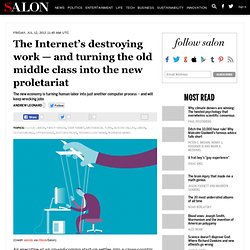
After the unthinkable torture of the ban on electronic devices ends, she pulls out her tablet, connects to Wi-Fi, and reviews her to-do list: Cancel cable TV service. Make dinner reservations at that annoying restaurant that doesn’t use Open Table. Research the entrance requirements for elite Brooklyn preschools. The prospect is disheartening, especially 35,000 feet high in the sky. A lot of hassle, a lot of time-wasting minutes spent on hold, a lot of unnecessary roadblocks preventing her from focusing her concentration on more important things, like getting her world-changing start-up up and running.
But no worries! Fancy Hands — “Do What You Love — We’ll Do The Rest” — is just one entrant in a growing cohort of companies that are outsourcing all kinds of humdrum work to the “cloud.” The best cloud labor start-ups have received plenty of laudatory press coverage and rave reviews from users. Sure. The 8 Habits of Highly Productive People. By Celes on Dec 2, 2010 | ShareThis Email This Post.

Management Leadership. All managers are leaders.
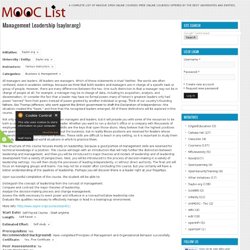
All leaders are managers. Which of these statements is true? Strategic Management video lectures, R. Srinivasan of IISc Bangalore. SEE: Guide to Download NPTEL Video Lecture Lecture Details : Strategic Management by Prof.

R. Strategic Management - Lecture 1. Strategic Management. What is strategy?
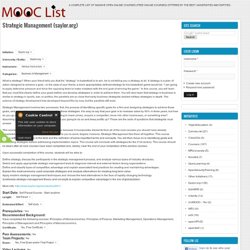
When your friend tells you that his “strategy” in basketball is to win, he is not telling you a strategy at all. A strategy is a plan of action designed to achieve a goal—in the case of your friend, a more appropriately defined strategy for his basketball game would be: “I am going to apply defensive pressure and force the opposing team to make mistakes with the end goal of winning the game.” In this course, you will learn that you must first clearly define your goals before you develop strategies in order to achieve them. You will also learn that strategy in business is similar to strategy in sports, war, or politics; the parallels are so close that early business strategists studied military strategies in depth.
The science of strategy development has developed beyond this by now, but the parallels still exist. Strategic Information Technology. Project Management. A Guide to the Project Management Body of Knowledge defines project as “a temporary endeavor undertaken to create a unique product, service, or result.
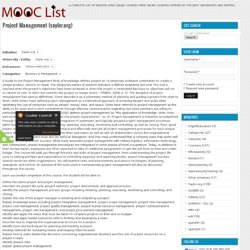
The temporary nature of projects indicates a definite beginning and end. The end is reached when the project’s objectives have been achieved or when the project is terminated because its objectives will not or cannot be met, or when the need for the project no longer exists.” (PMBOK, 2008, p. 5). The discipline of project management has various definitions. Some describe it as a systematic method of planning and guiding a project from start to finish, while others have defined project management as a methodical approach of achieving targets and goals while optimizing the use of resources such as people, money, time, and space. Risk Management. The Business Administration major is designed to prepare you for a leadership role in today’s highly competitive, global business environment.
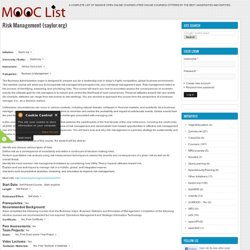
This elective course will allow you to incorporate risk management principles into your individual management style. Risk management refers to the process of identifying, assessing, and prioritizing risks. This course will teach you how to accurately assess the consequences of uncertain events; the ultimate goal for risk managers is to reduce and control the likelihood of such occurrences.
Personal attitudes toward risk vary widely (for example, attitudes can range from risk-averse to risk-seeking). You are advised to approach this course from the perspective of a business manager (i.e., as a decision maker). Unforeseen circumstances can occur in various contexts, including natural disaster, collapses in financial markets, and accidents.
Strategic Management - The New 7S framework. The New 7S framework 1.

Stakeholder satisfaction is the main focus of any organisational activity. The stakeholders include investors, employees, the larger society and most importantly, the consumer. If a new advantage is to be created it has to revolve around the consumer, be developed by the employee and funded by the investor. Employees must be empowered to generate new processes that can create value for the consumers. 2. Roles in change management. Change management roles:

SWOT Analysis. SWOT analysis (analysis of strengths and weaknesses) was developed by Igor Ansoff in his book Corporate Strategy and became a cornerstone of corporate planning.

It is still used, particularly in change management, marketing and product appraisal and also in personal development. Entrepreneurs' Organization - Fueling the Entrepreneurial Engine. Communicating Strategy: Ten reasons why people communicate strategy poorly. Science of Strategy Institute. What is a Work Breakdown Structure? Examples and Descriptions. Written by: Ann Gordon • edited by: Michele McDonough • updated: 10/24/2014 A Work Breakown Structure (WBS) is used for breaking down a project into easily manageable components, or bites.
Here we'll break down the process for you, making it easy to use these structures in your project planning. Company owners and project managers use the Work Breakdown Structure (WBS) to make complex projects more manageable. Congruence Model - Aligning the Drivers of High Performance. Aligning the Drivers of High Performance Performance comprises four interlocking elements. © iStockphoto/dt03mbb Is your organization's performance as good as it could be? What could be changed to improve things and why would this help? Does the key lie in the work itself? And why does one organization seem to thrive on a certain corporate structure or type of work, while another struggles to make a profit? The answer lies in understanding the key causes or drivers of performance and the relationship between them. It's a powerful tool for finding out what's going wrong with a team or organization, and for thinking about how you can fix it.
Understanding the Tool The Congruence Model is based on the principle that an organization's performance is derived from four elements: tasks, people, structure, and culture. Industry E-mail Newsletters for Professionals. What is project management? ‘At its most fundamental, project management is about people getting things done,’Dr Martin Barnes, APM President 2003-2012. What is project management? DefinitionProject management is the application of processes, methods, knowledge, skills and experience to achieve the project objectives. GeneralA project is a unique, transient endeavour, undertaken to achieve planned objectives, which could be defined in terms of outputs, outcomes or benefits.
Engineer Your Success In Canada.